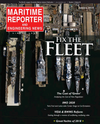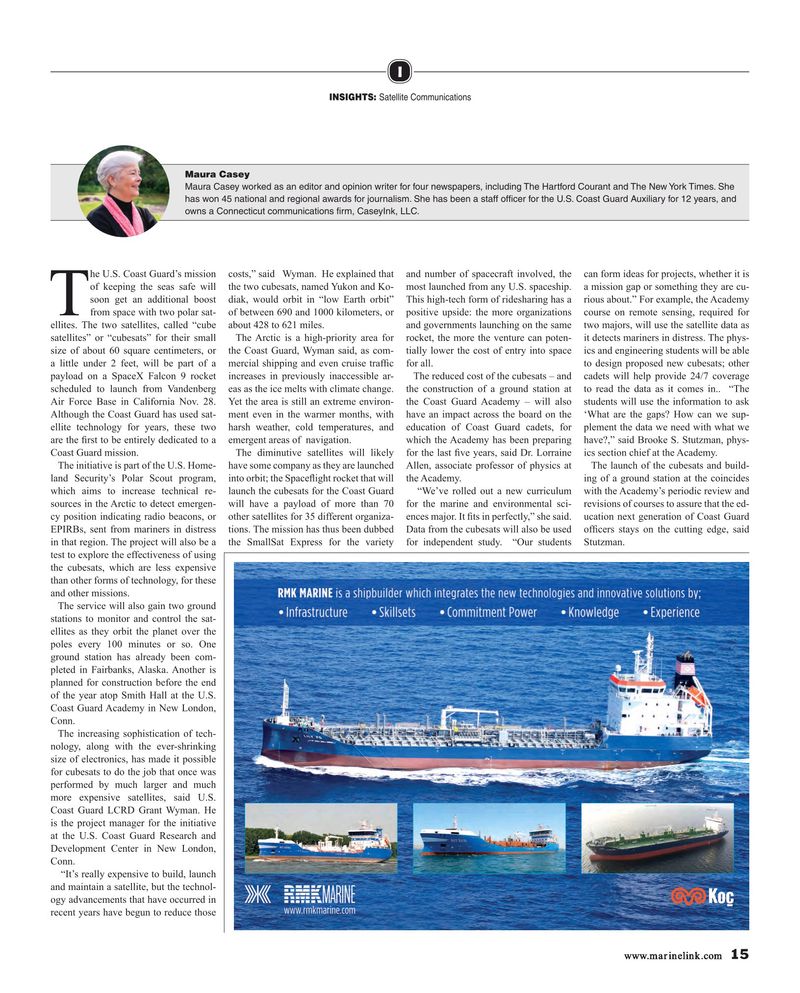
Page 15: of Maritime Reporter Magazine (January 2019)
Ship Repair & Conversion: The Shipyards
Read this page in Pdf, Flash or Html5 edition of January 2019 Maritime Reporter Magazine
I
INSIGHTS: Satellite Communications
Maura Casey
Maura Casey worked as an editor and opinion writer for four newspapers, including The Hartford Courant and The New York Times. She has won 45 national and regional awards for journalism. She has been a staff of? cer for the U.S. Coast Guard Auxiliary for 12 years, and owns a Connecticut communications ? rm, CaseyInk, LLC.
he U.S. Coast Guard’s mission costs,” said Wyman. He explained that and number of spacecraft involved, the can form ideas for projects, whether it is of keeping the seas safe will the two cubesats, named Yukon and Ko- most launched from any U.S. spaceship. a mission gap or something they are cu- soon get an additional boost diak, would orbit in “low Earth orbit” This high-tech form of ridesharing has a rious about.” For example, the Academy
Tfrom space with two polar sat- of between 690 and 1000 kilometers, or positive upside: the more organizations course on remote sensing, required for ellites. The two satellites, called “cube about 428 to 621 miles. and governments launching on the same two majors, will use the satellite data as satellites” or “cubesats” for their small The Arctic is a high-priority area for rocket, the more the venture can poten- it detects mariners in distress. The phys- size of about 60 square centimeters, or the Coast Guard, Wyman said, as com- tially lower the cost of entry into space ics and engineering students will be able a little under 2 feet, will be part of a mercial shipping and even cruise traf? c for all. to design proposed new cubesats; other payload on a SpaceX Falcon 9 rocket increases in previously inaccessible ar- The reduced cost of the cubesats – and cadets will help provide 24/7 coverage scheduled to launch from Vandenberg eas as the ice melts with climate change. the construction of a ground station at to read the data as it comes in.. “The
Air Force Base in California Nov. 28. Yet the area is still an extreme environ- the Coast Guard Academy – will also students will use the information to ask
Although the Coast Guard has used sat- ment even in the warmer months, with have an impact across the board on the ‘What are the gaps? How can we sup- ellite technology for years, these two harsh weather, cold temperatures, and education of Coast Guard cadets, for plement the data we need with what we are the ? rst to be entirely dedicated to a emergent areas of navigation. which the Academy has been preparing have?,” said Brooke S. Stutzman, phys-
Coast Guard mission. The diminutive satellites will likely for the last ? ve years, said Dr. Lorraine ics section chief at the Academy.
The initiative is part of the U.S. Home- have some company as they are launched Allen, associate professor of physics at The launch of the cubesats and build- land Security’s Polar Scout program, into orbit; the Space? ight rocket that will the Academy. ing of a ground station at the coincides which aims to increase technical re- launch the cubesats for the Coast Guard “We’ve rolled out a new curriculum with the Academy’s periodic review and sources in the Arctic to detect emergen- will have a payload of more than 70 for the marine and environmental sci- revisions of courses to assure that the ed- cy position indicating radio beacons, or other satellites for 35 different organiza- ences major. It ? ts in perfectly,” she said. ucation next generation of Coast Guard
EPIRBs, sent from mariners in distress tions. The mission has thus been dubbed Data from the cubesats will also be used of? cers stays on the cutting edge, said in that region. The project will also be a the SmallSat Express for the variety for independent study. “Our students Stutzman.
test to explore the effectiveness of using the cubesats, which are less expensive than other forms of technology, for these and other missions.
The service will also gain two ground stations to monitor and control the sat- ellites as they orbit the planet over the poles every 100 minutes or so. One ground station has already been com- pleted in Fairbanks, Alaska. Another is planned for construction before the end of the year atop Smith Hall at the U.S.
Coast Guard Academy in New London,
Conn.
The increasing sophistication of tech- nology, along with the ever-shrinking size of electronics, has made it possible for cubesats to do the job that once was performed by much larger and much more expensive satellites, said U.S.
Coast Guard LCRD Grant Wyman. He is the project manager for the initiative at the U.S. Coast Guard Research and
Development Center in New London,
Conn. “It’s really expensive to build, launch and maintain a satellite, but the technol- ogy advancements that have occurred in recent years have begun to reduce those www.marinelink.com 15
MR #1 (10-17).indd 15 MR #1 (10-17).indd 15 1/11/2019 10:38:56 AM1/11/2019 10:38:56 AM

 14
14

 16
16
